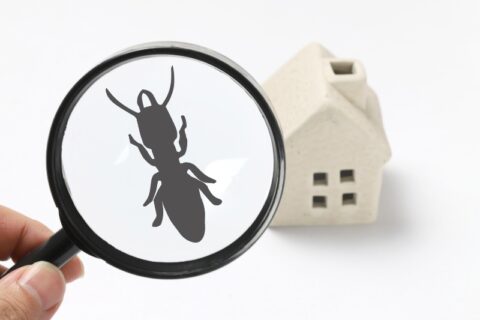Are Termites More Active in the Summer?
As the weather warms up, you might notice some termite wings in your window sills or around your door frames. How long have those things been there? Is it that you’re just now noticing them, or did they just appear? Are termites more active in the Summer?
Well, yes and no. Drywood Termites are more likely to be actively flying in the Summer, but it doesn’t mean they’re more active when it comes to eating your house. Here’s what is going on. In the Summer, Drywood termites called alates or swarmers leave their colonies in search of greener pastures. They’re reproductive termites looking for a mate and a new place to start a colony, and when they find those things, they drop their wings and settle down. So, wanderlust and the heat, are what make Drywood termites active in the Summer, and if you see discarded wings around your house, call for assistance as quickly as possible.
At least, if you see termite wings, that means they’re about to start a new colony and you may not already have a termite infestation, right? Wrong. Drywood termites often settle not too far from home, so if you’re seeing wings, they’re probably from young termites who grew up somewhere on your property. Termites don’t hibernate, so it’s entirely possible that you’ve had these little invaders munching on your house all winter long.
Of course, you may not see the Drywood termites themselves at all. Drywood termites are very good at staying hidden and may go undiscovered for years while they happily eat your home from the inside out. Because they’re so sneaky, it’s important to know how to look for subtle clues of an infestation. Here’s what to know about evidence of termites:
- You might see piles or scatterings of droppings. Drywood termite droppings look similar to piles or a scattering of sand or pepper but are wood colored. If it’s a pile of these droppings, the hole or “kickout” in which they were pushed out is likely directly above the pile of droppings. If the droppings are scattering on the floor or window sill, the hole or “kickout” in which the termites pushed them out is likely higher up at the ceiling, higher up on the wall, or at the top of the window framing.
- Look out for wood damage. You might not see this, because Drywood termites are often deep inside the walls. If you’re paying close enough attention, you might also notice that some of your wood sounds hollow or that the wood that was painted is now gone and all that is left is a paint shell.
- Sometimes, you might think termite damage is something else. Are your doors and windows warped or sticking? You may think it’s water damage or a sign that the house is settling but it could also be Drywood termites. A blistered appearance on wooden surfaces can also be termite damage.
- Of course, now we’re back to swarmers. You might see them in the evening, swarming near a light, or during the day flying around outside or on the insides of your windows as they are attracted to the sunlight and are trying to get outside. And the wings, as we’ve mentioned, will be dropped once they’ve decided to stay a while.
If you see any of these signs, it’s past time to schedule an inspection. You should schedule a termite inspection at least every few years if no activity is found so that a professional can go over every part of your house and determine if there are any signs of termite activity. If there are already termites, treatment can eradicate the colony. If you have an inspection and there are no signs of termites, preventative treatments may be recommended. Why? Because termites are extremely destructive and, if left to their own devices, can do extreme damage to a home. In addition to professional treatment, there are some steps you can take to keep your home safe from these intruders.
- Don’t let moisture accumulate. If you have a leak, fix it immediately. If your basement is damp, determine how to dry it out and waterproof it. Termites need water to survive and removing potential sources of water can help keep them out of your home.
- Check the exterior of your home for any potential water sources. Do you have any leaky faucets or water pipes? Is your exterior AC unit putting out excess water? Are any sprinklers pointing at your foundation? Rectify any problems you find. If any part of your fascia, soffits, or roof shingles is rotten, repair it. Clean your gutters and make sure the grade of your yard is sloped away from your house so that water does not pool around your foundation. Consider putting a strip of crushed rock around the foundation, to further deter them.
- Deny termites entry into your home. Don’t leave any room for them to breach your home’s exterior. Replace weather stripping as needed and repair any loose mortar around your basement foundation. Termites can get through a gap as small as 1/32nd of an inch, so take care to repair any cracks or gaps caused by the settling of your house. Seal cracks around gas lines and plumbing with caulk or foam sealant.
- Take care not to provide food sources for termites. Did you know that it’s not wood that termites are after, but cellulose? Cellulose can also be found in paper products. So, while it’s a no-brainer to keep rotting wood away from your home and remove wood left over from construction jobs, you should also know that newspapers, cardboard boxes, and other paper products stored in and around your property can invite a termite infestation. Recycle paper and wood products, keeping important papers on the upper levels of your home.
- Be careful with what’s touching your house. Keep firewood off the ground and away from the house. Reduce the amount of soil-to-wood contact around the house, taking care that soil or mulch only touches the concrete foundation. Keep shrubbery trimmed and at least a foot away from the house.
- Enlist the help of professionals. The most important thing you can do to protect your home from termites, in the spring and every other season, is to schedule regular maintenance with an experienced termite control company.
At MightyMite Termite Services, we’ve earned a reputation as experts in California termite control. We perform termite inspections to ensure that your home is free of termites and work hard to help you keep it that way, using treatments that are naturally derived and have a low impact on the environment. We diagnose and treat infestations with the most effective methods and unmatched warranties, solving your termite problems the first time, with an industry-best “no call-back rate.” That, combined with our experience, technology, and highly trained professional staff, makes us the leading extermination company in the Bay Area. We understand that your home is your most important investment, so we work hard to provide excellent service, utilizing best practices to solve our customers’ termite problems in Northern California. For more information, email Info@mightymitetermite.com, call us today at 408.335.7053, or contact us through our website.








